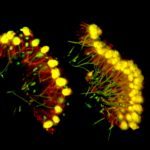Link to Pubmed [PMID] – 26172338
Link to DOI – 10.1002/bies.201500027
Bioessays 2015 Aug; 37(8): 836-50
The origin of the notochord is one of the key remaining mysteries of our evolutionary ancestry. Here, we present a multi-level comparison of the chordate notochord to the axochord, a paired axial muscle spanning the ventral midline of annelid worms and other invertebrates. At the cellular level, comparative molecular profiling in the marine annelids P. dumerilii and C. teleta reveals expression of similar, specific gene sets in presumptive axochordal and notochordal cells. These cells also occupy corresponding positions in a conserved anatomical topology and undergo similar morphogenetic movements. At the organ level, a detailed comparison of bilaterian musculatures reveals that most phyla form axochord-like muscles, suggesting that such a muscle was already present in urbilaterian ancestors. Integrating comparative evidence at the cell and organ level, we propose that the notochord evolved by modification of a ventromedian muscle followed by the assembly of an axial complex supporting swimming in vertebrate ancestors.

